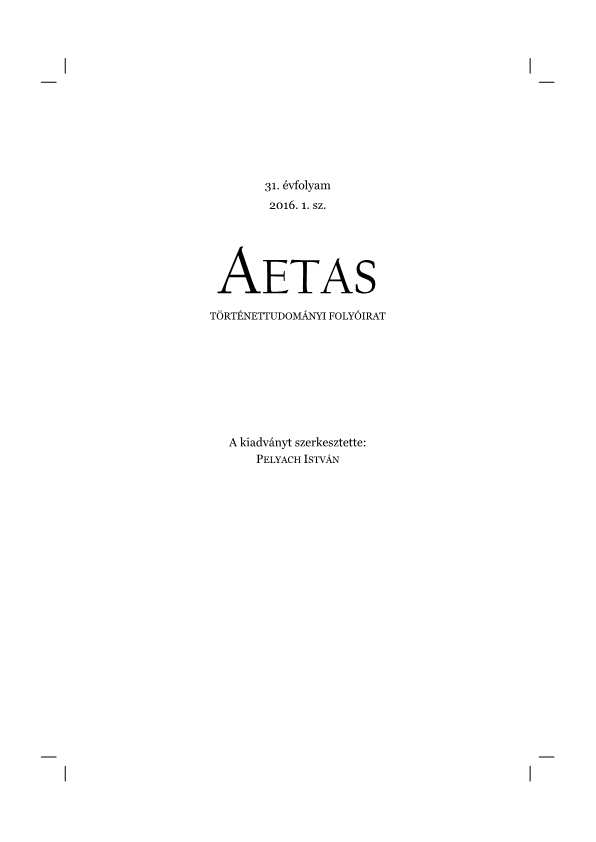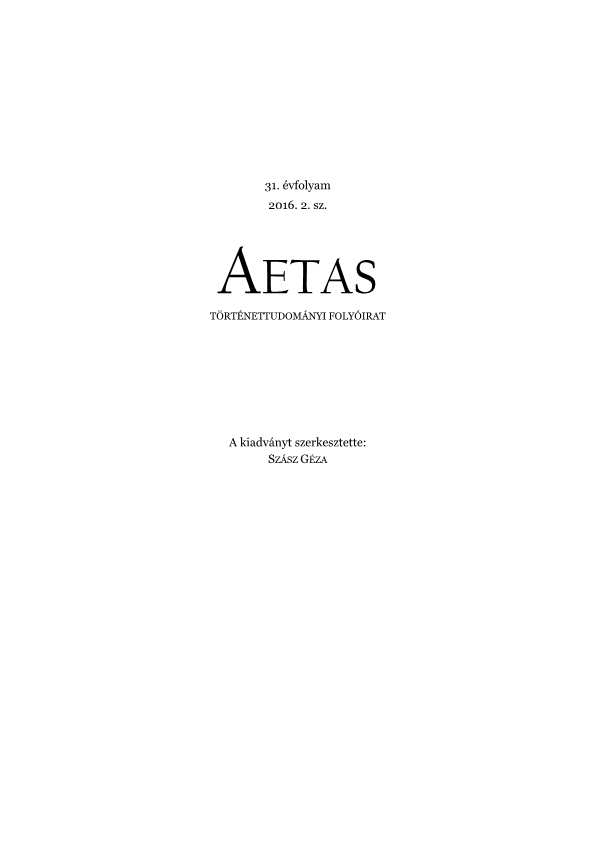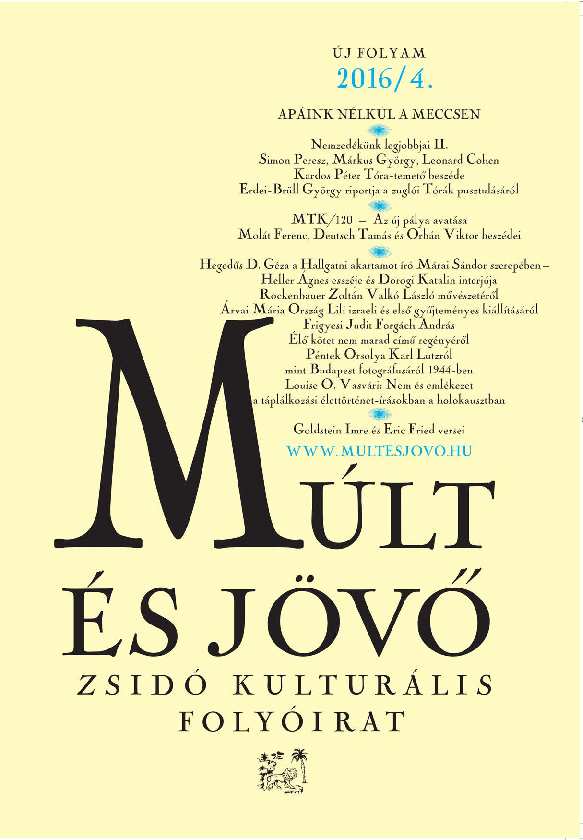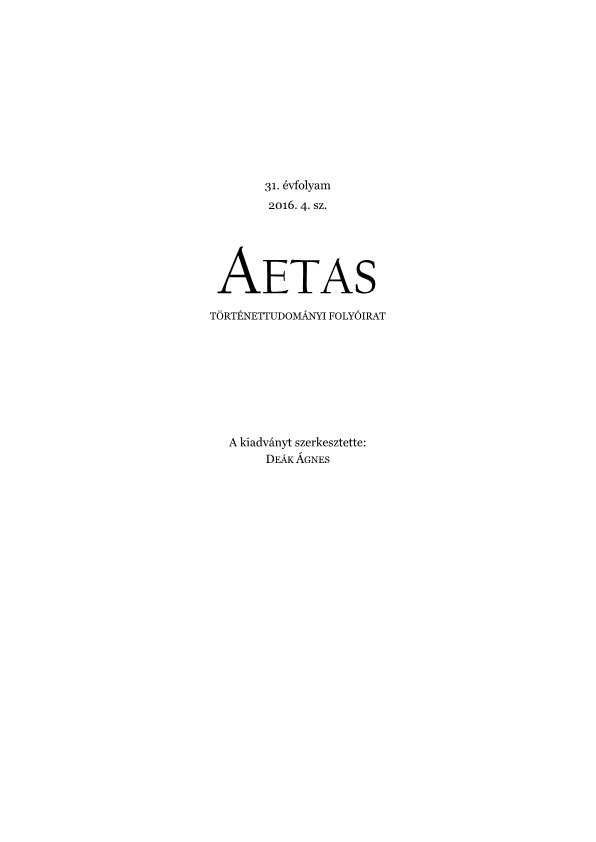We kindly inform you that, as long as the subject affiliation of our 300.000+ articles is in progress, you might get unsufficient or no results on your third level or second level search. In this case, please broaden your search criteria.


B. Müller Tamás: Vörösterror az Országházban 1919. Országgyűlés Hivatala, Budapest, 2016. 324 oldal
More...
Advocated in Western Europe, the modern concept of cremating the deceased became known to Hungarian progressive thinkers at the end of the 19th century, although it was only between the two World Wars that the first crematory was opened in the city of Debrecen. The most pronounced objections against cremation were formulated primarily by the Catholic Church, but neither did the Protestant and Jewish churches support the first steps. In the meaningful debates historical, legal, esthetic, public health-related as well as economic factors were lined up, but throughout the controversy that lasted for seventy years the most important goal of the Catholic Church remained the same: to preserve its privileges; while the communist regime focused on wiping these out. It is important to note that during its short reign, the Revolutionary Governing Council ratified a cremation bill but it lacked the means and the infrastructure for its practical implementation. Another crucial thing to keep in mind is that although the city council of Budapest wanted the capital to be the first city in the country to have a crematory, they could not attain their goal due to the objections of the Catholic majority. For this reason, Budapest did not have the priority over Debrecen, a Protestant city enjoying the homogenous support of its leadership and inhabitants. By the beginning of the 1950s, the communist leadership finally managed to silence the objections of the church, but the construction of the crematory in Debrecen was already concluded in 1932 owing to the city’s previous leadership and the outstanding work of József Borsos. The Council of Ministers had nothing else left to do than rectify the cremation bill, which was done in 1951 by the interior ministry. At the beginning of the 1960s, a shift in the reviving Catholic Church’s viewpoint began to unfold as a result of which cremation was deemed acceptable. In the years following the millennium, altogether there were ten crematories nation-wide, providing the burial service preferred by approximately one third of the population.
More...

François Cadilhon – Philippe Chassaigne – Éric Suire (dir.): Censure et autorités publiques. De l’époque moderne à nos jours. P. I. E. Peter Lang, Bruxelles, 2015. 360 oldal
More...
Memoirs written by Holocaust survivors and (in some cases) their testimonies retain a salience unmatched by other historical sources. This article discusses one such memoir, Olga Lengyel’s Five Chimneys, alongside her 1998 testimony, aiming to engage with broader methodological issues relating to the history of the Holocaust, particularly those about memory, narrative and textuality. Through a detailed discussion of certain moments shaping Olga Lengyel’s personal experience, both pre-and post-arrival in Auschwitz, the article captures the tensions and contradictions characterizing the harrowing story of one woman’s loss of family in the Holocaust.
More...
While some journals elected to print or reprint Vangelis’ academic history articles in commemoration of him, Südosteuropa has decided to arrange for one of the discussions Vangelis led to be translated. The subject was the role of history in the public sphere, and we chose it because on the one hand, Vangelis had placed great importance on the subject of public history in recent years, and on the other hand because it reveals another side of his character as much as of his work, and we felt it worth commemorating. For Vangelis, history was social interaction, a discussion, a process of give-and-take, something, we believe is best illustrated by that subject, in that format. Our special thanks go to Malte Fuhrmann for selecting this particular text and for adding contextual information to the original footnotes that will be useful to an international readership. We are grateful to Ceyda Arslan Kechriotis for her permission to publish the text in this English translation.
More...

In the autumn of 2010, a history conference entitled “Történelmi átértékelés” (Historical Transvaluation) was organized in Székesfehérvár. Timed to coincide with the 125th anniversary of the birth of Bálint Hóman, the symposium aimed at paving the way for the rehabilitation of the historian and politician. The conference title was borrowed from a lecture written by Hóman in 1930, in which keeping his ideological motives hidden in the background he identified two possible reasons for transvaluation: “There are two sorts of reasons that may justify the transvaluation of historical phenomena: either an expansion in the availability of historical sources, an emergence of new data and a new interpretation of the old ones, or the emergence of new points of view in research that arise from the application of new methods of inquiry either unknown to, or ignored by, the historians of the past.” The concept of transvaluation provoked a lively discussion and played a key role in Hungarian historiography on several occasions until the change of the political regime in 1990. The article follows the practice of Hungarian historiography related to the conceptual construct of “transvaluation” throughout the 20th century
More...
The paper discusses Sándor Domanovszky’s historical and historical political views. After briefly summarizing the literature on Domanovszky, the author focuses on two main problems in his treatment of the subject: on the one hand, Domanovszky’s debate with Romanian historian Nicolae Iorga, and his clearance procedure in 1945, in which the so called Tibor Baráth case and the involvement related to the grand prize awarded by the Hungarian Academy of Sciences to Gyula Szekfű in 1943 played a decisive part. According to the author’s conclusion, contrary to previous views, it was not positivism but rather a historicism centering on the national problematics as well as intellectual history that primarily influenced Domanovszky’s work in the last period of his life.
More...
L’etude analyse premièrement les adnotations du président de la Republique francaise, Raymond Poincaré dans ses mémoires Au service de la France concernant les négociations de l’Entente avec la Roumanie pour aboutir au traité de 17 août 1916 et à l’entrée du royaume dans la Grande Guerre, dix jours après, dans les conditions de la meurtrière bataille de Verdun et des maigres résultats l’offensive sur la Somme. Avec les mémoires du président français on met également en valeur sa lettre de 5 août 1916 au tsar Nicolas II, – comprise dans les infra-pages des La Russie des Tsars de Maurice Paléologue – pour parachever les négociations avec la Roumanie. Le président Poincaré résume les décisions du Conseil de Défense de la France au lendemain de l’entrée de l’armée roumaine en guerre, ou on trouve la mention, ignoré, d’un accord Briand-Lloyd George pour une aide militaire substantiel russe pour la défense roumaine de Dobroudja. En utilisant aussi les télégrammes envoyées par le Grand Quartier General français au général Sarrail à Salonique, l’auteur prouve que le généralissime Joffre, d’accord avec le général Alexeiev, et d’autant avec le général Sarrail n’ont pas envisagé une offensive contre la Bulgarie, quoique cette offensive était prévue dans la Convention militaire avec la Roumanie de 17 août 1916. Les pertinentes observations du roi des Belges, Albert Ier sur les espérances nourries par les Alliés au momment de l’entrée de l’armée roumaine en lutte, en flagrante contradiction avec le veritable rapport des forces dans le sud-est européen, closent l’étude.
More...
The battle of Verdun was reflected in the Romanian newspapers by news coming from the press agencies, but also by their own comments written by editors or by military or civilian collaborators. In this study I utilized articles from „Universul”, „Adevărul”, „Minerva”, and from „Săptămâna războiului”, a weekly supplement of „Adevărul”. The news were usually presented and commented according to the general political direction of the publication („Minerva” was Germanophile, and its biased view increased as the Germans were loosing). The manner in which the information was desired to be receipted by readers is reflected in the composition of the titles and subtitles, and also by the increasing number of articles on the front-page. The comments emphasized the importance of the fulfilling battle for the fate of the war, but also for the issue of the entrance in action of Romania. The most expert were those of general Grigore Crăiniceanu from „Universul”. The news about the resistance of the French army confirmed the expectations of the majority of the public opinion, contributing perhaps to convince some Germanophiles that the Entente has a chance to win.
More...
The battle of Verdun detains a prominent place in the memory and the historiography of the First World War. The present article analyze the manner in which the Romanian historiography analyzes and reflects the impact of the battle on the general course of the World War and on particular evolution of the Romanian front during the campaigns of the years 1916-1917.
More...
The study below analyses a subject that was insufficiently covered by the Romanian historiography, namely the participation of the militias troops to the campaign of 1916. The militias represented a reminiscence of the military organization of the second half of the 19th century. According to the law of 1913, they incorporated the persons deemed able for military service, but with ages between 40 and 45. They were poorly equipped and poorly trained, the same being valid for the officers. At the start of the hostilities, the effectives of the militias totaled 160 000 men. They were organized in battalions and entered the composition of the four Romanian armies. Despite being unprepared for combat, the battalions of militias were used in major operations, such as those from Turtucaia, Câmpulung, Văile Topologului, Olt and Jiu valleys, etc. In most situations, they weren’t very efficient, with the exception of the first battle on Jiu River (October 1916), when their intervention was salutary. The participation of the militias in the confrontations during the fall of 1916 represented a necessity, as the fighting on two fronts required very large effectives. At the same time, their use into combat represented an error, as they were not as efficient as expected.
More...
The Great War from 1914-1918 has clearly been first a hegemonic war, if one uses the words of Neorealist author Robert Gilpin: the great powers prepared for it and fought it in order to get new spheres of influences and territories, resources, populations, and also to prevent the rival ones to become too strong in the near future. On the other side, small and medium-sized states like Romania prepared for war and entered into it with the aim of receiving those territories and populations inhabited by their ethnic-kin populations and belonging to multinational empires like the Austro-Hungarian and the Tsarist ones. The author asks the question if Romania entered the war after two years of neutrality aiming at balancing against the enemies, against the most threatening state (Russia), or to align with the likely victors, as both the Triple Entente and the Central Powers coalition promised it to offer territories from the defeated enemy empires. But in August 1916 no likely victorious coalition had emerged and Romania finally did chose to ally with the Entente, thus also with Russia, which had been previously seen as the biggest danger for its national security. The collective desire to get the rich and beautiful Transylvania, the Bukovina and the Banat (or at least part of it) prevailed against the fear of Russia (and the alternative scenario of receiving Bessarabia), but the decision was not a bandwagon-like calculus as Russia was not at all superior in military forces, technology and economy to Germany, the leading state of the Central Powers.
More...
Once with the outbreak of World War 1, the system of alliances that resulted following the Balkan Wars proved its futility. The Greek-Serbian alliance of 1913 did not compel Greece to enter the war when Serbia was attacked by the Austro-Hungarian Empire, in 1914. The Balkan stage became polarized and the desire to maintain neutrality proved to be illusory. In Greece, the pro-Entente political forces, coagulated around the charismatic liberal prime-minister Eleftherios Venizelos, opposed the forces who favoured the Central Powers, represented first and foremost by King Constantine I. The ambassadors to Athens of the states from the two major alliances played an important role, as they exerted their influence on the decision makers of the Greek state: the Crown, the Government, the General Staff, the Parliament, the political parties and, secondary, the public opinion, the Orthodox Church, the press. The present article analyses in detail the first phase of the events, from the start of the war to the operation in the Dardanelles.
More...
After the Madrid Summit in 1997, regarded as a politico-military failure, or at least a semi-failure, if we take into account that at least in the military domain, the three invited countries to join NATO – the Czech Republic, Poland and Hungary – did not have achievements well above our country, NATO has initiated the Partnership for Peace Enhanced Programme for Education and Training, has started to developing the Persistent Partner Simulation Network Capability and has begun to implement the concept of Partnership Staff Elements (PSE) Development of a Persistent Partner Simulation Network Capability, as one of the main vehicles necessary to ensure the participation of staff officers from PfP countries to “NATO-led PSO operations with the participation of partners”. Also within this concept, NATO has intended to offer various positions in some of its commands, subject for selection and appointment of partner officers and NCOs, both as an opening of the Alliance and as a method of enhancing military training in the armed forces of these countries. In this context, in the summer of 1997, NATO has sent to Romania a significant and consistent dossier with positions that will be assigned to Romanian staff officers and NCOs. The article highlights some of the unknown details regarding the first Romanian officers selected and appointed in various positions to NATO HQs, national and the Alliances’ efforts and difficulties they have to manage to implement the PSE concept, as well as duties, responsibilities and the activities performed by the first Romanian Staff Officer for Operations and exercises, officer selected and assigned to Commander In Chief Iberian – Atlantic Area. Some of personal thoughts, visions and points of view are also highlighted.
More...